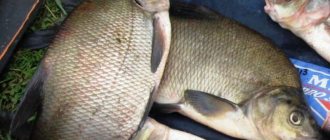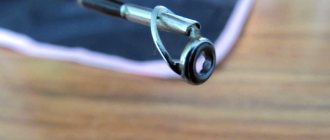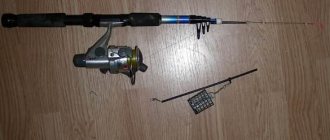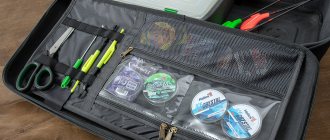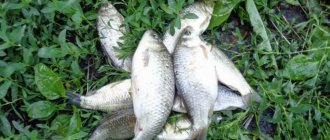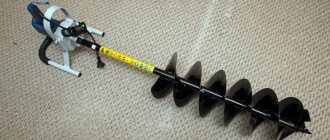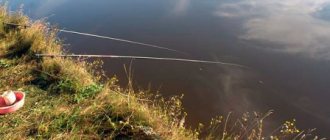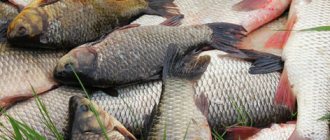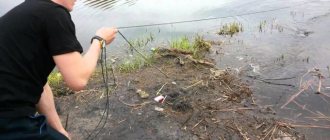Fishing is one of the favorite hobbies not only for men, but also for women. A large number of different fishing methods have been developed, from the simplest to the most sophisticated, which guarantee the fisherman a big catch.
Among such methods, ring fishing is known. To try your luck in practice, you need to know how to catch a ring with a tackle, what it looks like and what are the features of such fishing.
Is it possible to fish with a ring?
The ring is a fishing tackle suitable for those who are accustomed to action, and not just taking part or observing. In Soviet times, the use of this fishing gear was prohibited. First of all, the law was aimed at preserving the bream population, because even a poacher could sometimes envy the catch for a ring.
Despite the previously existing ban, ring fishing is now allowed, because the ring cannot be called the only successful method for catching bream, and poachers are constantly improving their tools.
By the way, everyone runs the risk of becoming a poacher: keep an eye on the daily catch limit for bream or ide when fishing with a ring, and then Rybnadzor employees will not pay attention to you.
Drawing of a ring ring for bream

A drawing of a bream ring blank is in front of you.
To make a ring with your own hands, we roll out a long stump of lead into a round rod, gradually giving it the shape of two cones with bases in the middle of the lead blank. The length is indicated in the drawing, the thickness of the rod in the middle is about one and a half times greater than at the ends.
The lead blank of the ring can be rolled out using the technology of making lead jigs with your own hands, after which we obtain a round profile in any section of the blank. See the position of the drawing on the right, where the end of the round rod is shown.
In principle, the blank ring for catching bream can be left in this form, but we need a straight outer plane to which we can solder an elastic spring.
Therefore, we then place the ring blank on a flat metal plate and, using hammer blows, placing a steel plate on the lead rod, we give the lead even planes along the entire length of the blank on both sides.
As a result, we will make our own lead rod with two straight opposite planes and two semicircular sides. We turn the rod 90 degrees and perform the same actions with rounded planes.
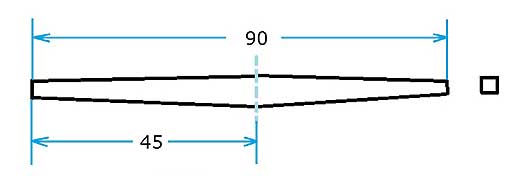
Ultimately, we will produce the rod of the ring for catching bream shown in the drawing with 4 even planes. And it will be better if the edges on the workpiece have slightly rounded corners.
We cut the rod to the required length. Let the dimensions of the ring blank from its dotted line in both directions be equal to 45 millimeters. This means that the entire length will be 90 mm.
How to bend a ring tackle ring
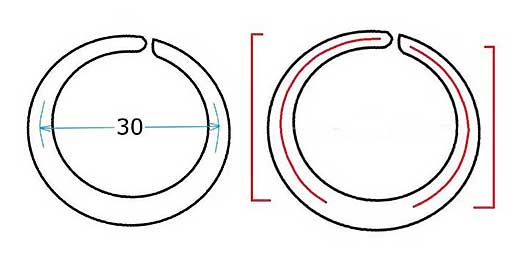
The ring of fishing tackle for catching bream in the current can be bent around some kind of round rod. Why do we find a metal pipe, a wooden handle of a shovel, mop, lazy bar with a diameter of 27-28 mm and bend (not yet completely) a lead blank around the handle or tube along one of the flat planes.
After bending the ring, we grind the ends of the workpiece so that in the future there will be no problems with the fishing line slipping through its slot. We bend the rod completely, giving it a round shape. See the image of a completely self-made ring for catching bream in the left position of the drawing.
All that remains is to make with your own hands some suitable clamp for the curved ring, which fixes the wound line of the ring feeder in the round cavity in real conditions of catching bream in the current from a boat.
Where is the fishing tackle called a ring used?
Ring fishing tackle is used in bodies of water with a current, but in stagnant water its use is ineffective. The ring is designed for fishing from a boat, but experienced fishermen successfully use it when fishing from hydraulic structures.
The advantage of ring fishing from a boat is the ability to get to the most promising places:
- pit;
- brow;
- hard-to-reach areas under steep bank cliffs or trees.
Using an echo sounder greatly facilitates the search for catchable places, but on a familiar body of water a fisherman will be able to find such areas without using it. Bream prefer to swim close to holes.
The fish also concentrate in snags, but ring fishing among the bushes is problematic. In any case, the fish come out to the adjacent territory to feed. Fishermen need to take into account the fact that bream is cautious and therefore lives at a depth of at least 5 meters, and at shallower depths the outline of a boat will scare it away.
Professional advice!
Having arrived at an unfamiliar body of water, it is recommended to join local fishermen who, over many years, have managed to study bream trails and the bottom. Some will even tell you about the preferences of the fish, thereby making the choice of feeding easier.
Ring shape for bream
A couple of designs of rings of different shapes for catching bream with a ring have been unearthed in fishing magazines.
The next picture shows a ring ring, similar in shape to my homemade ones. Only here the role of a pressure spring is played by a steel elastic wire driven into lead.
Thick, unbraided steel guitar strings can be used as a spring device on a round ring.
And I would increase their length, and solder the places where they are rigidly connected to the lead ring with tin-lead solder.
The next picture shows a ring of gear for catching bream with a somewhat elongated shape.
We once tried a similar design of a ring with antennae made from thick guitar strings.
The rings are quite functional when catching bream on the river current, only the antennae of our rings were slightly wound on top of each other. In this manner, you can adjust the operation of the ring to suit the sharpness of the hooking of the bream.
The swivel present in the lower image is a limiter for the travel of the ring when catching bream in fishing conditions. The main line is tied to it on top, and one or two leashes can be tied to the bottom.
What time of year can you fish with a ring?
Bream are active from the beginning of April until the end of September. In this case, the most catchy period is considered to be the period before spawning.
Further, with the onset of hot summer, its activity during the daytime decreases and it is possible to catch cautious fish in the evening or even at night at great depths (from 5–6 meters).
The second most catchy period is in September, when the water temperature drops below 20 degrees. At this time, bream is actively preparing for the upcoming winter and feeds all day, preferring a depth of 6–8 meters.
Fishing with a ring in winter is dangerous, as the boat and anchor cables become icy.
Fishing technique
When all the preparatory procedures are completed, it’s time to set sail. When a suitable fishing spot has been found, you need to anchor the boat. The best way to do this is to use a couple of anchors. If you plan to fish in a small current and use a large feeder, then you can get by with one anchor. After the boat is anchored across the current and the feeder is lowered to the bottom of the reservoir, you can proceed to fishing.
We fasten the ring to the cord from the feeder. We put bait on the hooks. After this, we smoothly lower the ring with the bait to the bottom until it touches the lid of the feeder. Then we release a little of the main line so that the hooks are slightly carried away from the feeder by the current, tighten the line and wait for a bite.
The principle of fishing with a ring is quite simple - the current washes the bait out of the lid, the bream comes up to feed and gets hooked.
If the bite weakens, you can pull the feeder by the cord. This will agitate the bait in it and increase its leaching.
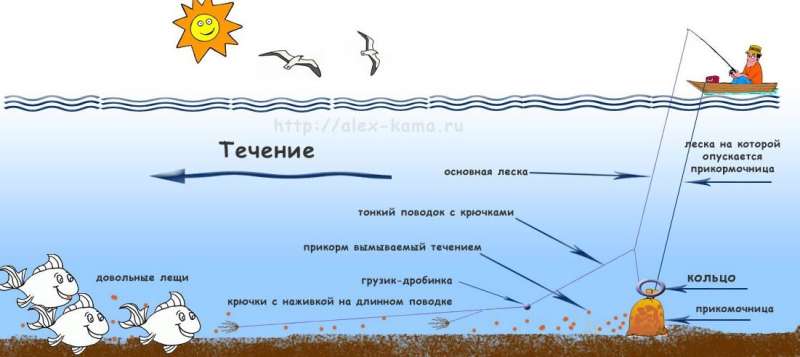
Choosing a fishing spot
When choosing a place to catch bream using a ring tackle, fishermen recommend paying attention to deep reservoirs with a current, soft soil, and fairway holes. The easiest way to find bream is with an echo sounder.
When exploring the river bottom, preference is given to the following places:
- channel turn;
- places where the river narrows;
- deep holes;
- eyebrows;
- snags.
At the same time, they look for bream not in the listed places, but not far from them - 15-20 meters away, where it is easier for bream to find feeding.
Ring leashes for weak currents
The ring leashes when fishing for bream on a weak river flow must be long, otherwise a problem may arise.
The fact is that after a sharp empty hook and the feeder line slips out of the clamp, the ring turns into an ordinary bottom weight, which can lie much closer to the side of the boat than the feeder located on the bottom, which is unknown to how far the current can carry it from under the boat.
As a result, the hooks on the ring leashes can get caught in the mesh of the feeder due to too weak a current in the river.
To prevent this from happening, it is better to limit the movement of the ring along the line of the tackle from below with a small, hand-made light plastic ball. You can put it on the main fishing line of a ring for catching bream in the same manner as you put leashes for pike perch.
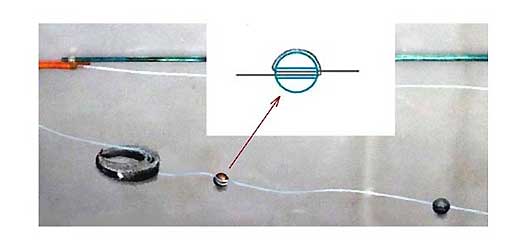
Descent and diameter of ringing line
The position of the ball regulates the descent of the main line of the ring below the ring. A small lead sinker is usually placed between the ball and the hook, which presses the leash or main line to the bottom soil if the bream is caught with a ring in a strong river current.
If the current is weak, then the nozzle on the hook of the ring will play the role of a weight.
The recommended diameters of the fishing line and leashes on the ring depend not only on the expected weight of the bream, but also on the speed of the river flow.
When I fished with this gear, I put a main line with a diameter of 0.25 mm on my ring, and the thickness of the leader line was 0.18-0.2 mm.
DIY ring manufacturing instructions
Ring tackle is sold in most fishing stores, but you can make it yourself. The process itself is simple, it is enough to have lead blanks. If there are none, then they are smelted from lead plates from a car battery.
Step-by-step description of how to make a tackle ring with your own hands:
- A model of the ring of the required size is prepared from plasticine.
- 4 small (2 cm) pieces of copper wire are threaded into the ring in a perpendicular direction. Wire thickness – 1 mm.
- Prepare a plastic container the size of the plasticine ring, about 2 cm deep, and place the ring on wire legs inside.
- A gypsum mixture is poured into a prepared container with a plasticine model and left until completely dry.
- Carefully remove the plaster mold and cut with a hacksaw in the middle of the plasticine model.
- The plasticine and wire are carefully removed, and the remaining holes from the “legs” are filled with plaster.
- The finished halves of the mold are connected, and the cut site is reinforced with plaster.
- As the mold hardens, 2 holes with a diameter of 8 and 3 mm are drilled in parallel to an empty mold.
- After this, the gypsum blank is disassembled into halves, and a 0.5 mm thick stainless steel braided ring with a “whisker” is placed inside the smaller hole.
- The plaster mold is reconnected and the joints are coated with plaster.
- After the mold has hardened, lead is poured inside through a larger hole and left until it cools.
- To remove the ring, the plaster is broken, and the ring itself is processed with a file until smooth.
As a result, the master receives a ring, where the inner part is used to slide the feeder along the rope, and the stainless steel fastening ring is intended for fishing line.
Ring design
When the ring fishing method just began to spread among fishermen, many used ordinary washers. They were attached to the end of the fishing line and an additional leash was tied. The fishing line from the feeder was threaded inside the hole.
This ring fishing tackle did not produce accurate bites and required significant modifications. Over time, the method was refined and as a result, fishermen received a highly sensitive “ring” tackle, which gives out even the most cautious bream.
Ring fishing gear
The necessary equipment for a fisherman heading to a reservoir to catch bream with a ring includes the following items:
- A rod about 1-1.5 meters long or a ready-made onboard rod.
- Coil. Inertial and non-inertial are suitable.
- The fishing line is 20 meters long, with a diameter of 0.3-0.4 mm.
- The leash is 40–50 cm long, the thickness of the fishing line is 0.15-0.2 mm, which is suitable for neat but large bream.
- Hooks are selected depending on the type of bait and the planned catch. When fishing with bloodworms, a size 14–16 is suitable, for a worm – 6–10. It is more convenient to place plant baits on 8–14 hooks.
- Nod for fishing with a high sensitivity ring to receive a signal about what is happening on the bottom.
Feeder
A feeder for fishing with a ring will be the determining factor for successful fishing.
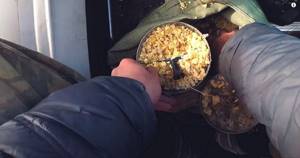
A flap or feeder is selected based on the characteristics:
- Capacity from 2 to 6 kg of complementary food mixture.
- The size of the feeder cells is selected depending on the strength of the current. The weaker it is, the larger the cells and vice versa.
- The material doesn't matter. It is acceptable to use fine mesh vegetable bags, wide plastic bottles with many holes of different diameters, fine mesh cages, or ready-made feeders from the store.
- Weight for fixing the feeder at the bottom. This could be a brick or a lead washer placed inside. Recommended weight: 2–3 kg.
- Correct installation of the feeder is done on a thick, strong fishing line or nylon cord of the feeder, which will withstand tension and ensure free sliding of the ring.
Fixed ring
Fixed type ring in outer diameter ranges from 50 to 70 mm. The thickness of the tackle does not exceed 8 mm. In the central part there is a hole with a diameter of 25–30 mm, which is necessary for the free movement of the ring along the cord from the feeder.
There are 3 types of fixed ring:
- Classic - the hole is drilled from top to bottom, perpendicular to the plane of the tackle. However, when this type comes into contact with the feeder, it will inevitably come across hooks.
- Oblique - the hole is made at an angle of 30 degrees relative to the plane of the ring, which reduces the likelihood of snagging.
- At a right angle - a hole begins to be drilled in the upper part of the ring with the outlet to the side. This type is considered the most reliable, with which snags do not occur at all or extremely rarely.
The small hole in diameter should be small, but sufficient to ensure free entry of the fishing line with the leash. The leash, in turn, is separated from the main line by a swivel. The ring moves along a stretched line from the feeder in an up and down direction.
Note!
A non-removable type ring is suitable for catching small fish whose weight does not exceed 1 kg.
Removable ring
The difference between a circuit-type ring is the ability to independently unhook the tackle from the cord to fish for fish.
There are several types:
- With a cut - one of the most popular and simplest. This is such a simple ring, the ends of which are not compressed and form a small gap. Often the ring spontaneously jumps out from the cord of the feeder or fails at the moment of hooking a large bream and does not jump out.
- With antennae - wire antennae are soldered into the structure. Their length ensures free crossing with an overlap of 6–10 mm.
- With a latch - an option identical to a ring with antennae, with the difference that the latch works like a door, opening when a large fish is caught on the hook.
Ring fastening
After preparing the rod and installing the reel with fishing line, the fisherman begins installing the gear. The fishing line is threaded through a narrow hole in the tackle, a small bead and an elastic band are put on.
The next step is to attach the swivel with the clasp, and then the leash.
Gear device design
There are several types of rings.
Fixed view
The layer of the ring, the diameter is from 4 millimeters, the diameter is 50-60 mm. A hole within 20 millimeters is drilled in the center of the product. This opening monitors the movement of the gear according to the cord attached to the feeder. In addition, another opening is drilled in the edge.
The diameter corresponds to 6 millimeters. The leash and fishing line are also strengthened here. If the opening is smaller, then the fishing line simply slips through it without being reeled in. In this case, a swivel is needed to secure the movement of the leash.
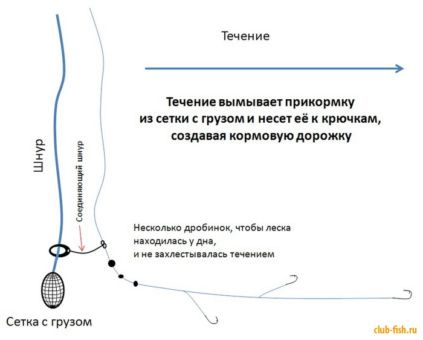
The ring is removable
In order to make the ring removable, you need to make a cut. It is done on the opposite side where the fishing line is located. It is cut out exactly like the opening for strengthening the leash. Such permission will allow the ring to jump off the cord at the moment the fish is hooked.
Direct cutting is not reliable because it can come out of the cord without your support. If you are faced with a similar problem, a small door using a spring can help. It is important that it opens outwards, but not inside the ring.
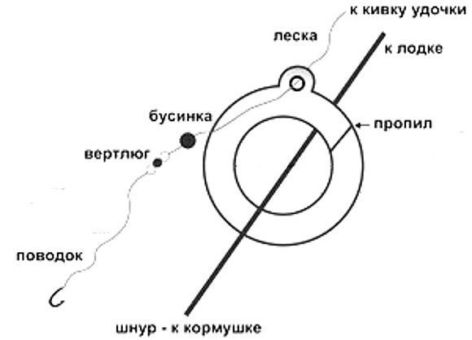
Testicles
Nowadays, the rings have been replaced by an advanced version called testicles. The essence of this system is based on the fact that 2 lead balls are fixed together with a wire. Which is shaped like a pin. Due to the fact that the wire is springy, the balls press tightly against each other, forming an excellent channel for the cord.
The wire of the feeder moves between them without finding any obstacles. During this period, a fishing line is placed in the ring of wire. At the moment of biting, the pressure causes the balls to move apart, while placing the feeder with fishing line on different edges.
When using a ring, you should adhere to several rules. Under no circumstances should the bit be long. It is best to use a spinning type. Elastic steak, long slope, which will compensate for the power of the waves and increase the effectiveness of the bite.
The optimal diameter of the fishing line is 0.3 millimeters; for a leash, 0.2 mm is suitable. Fluorocarbon works perfectly; fish don’t see it, but due to its density, it is more correct to use a diameter of 0.35 millimeters.
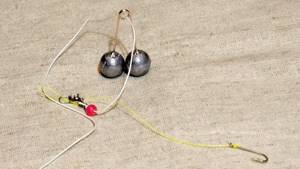
The length of the leashes is recommended from half a meter to 1.5 meters. This is necessary so that the current will pull them further away from the feeder. And so that they can fit on the bottom. However, the main thing here is to take into account the personal characteristics of the flow.
Types of groundbait and bait
Bream actively feed on bread, corn flour, semolina and sunflower cake - this is a favorite delicacy. A less popular, but still workable option would be peas and pearl barley.
When preparing bait for ring gear, keep in mind that it should create turbidity and spread freely along the flow of the reservoir. This way the fish will sense the smell and rush to its source. The composition of the bait is coarse-grained so as not to attract small fish.
To enhance the effect, you can use flavors, but be careful. An overly strong smell will not only not attract fish, but will even scare them away.
For information!
Favorite “flavors” of bream are anise drops, unrefined oil or vanilla.
Also, the fisherman can stock up on ready-made bait mixtures, which are highly effective, and the fisherman will not have to while away the time in the kitchen cooking.
An important detail when fishing, especially in winter, will be bait. Worms, maggots or bloodworms are suitable, since they predominate in the diet of bream in the cold season. In summer, fish bite more actively on plant components.
Ingredients
When preparing bait, it is necessary to take into account the preferences of the bream.
The list of favorite products includes:
- compound feed, cat or dog ready-made dry food;
- ground roasted sunflower seeds;
- corn flour;
- semolina;
- biscuit;
- breadcrumbs;
- fried rolled oats;
- bran.
Add as a coarse component:
- half-cooked millet, pearl barley;
- steamed peas, beans;
- canned corn;
- oats;
In winter, it is recommended to add chopped worms, bloodworms or maggots.
Aroma
A moderate, pleasant aroma attracts fish.
The list of flavors consists of:
- anise, sea buckthorn, hemp, sunflower oil;
- powdered milk or egg powder;
- garlic, dill;
- cinnamon or vanilla, cocoa.
For sweets, honey, chocolate or fruit syrup are added to the bait.
Color
The shade of the prepared bait should match the color of the day in the selected reservoir. Give preference to moderately light ready-made mixtures that will not become a bright light spot against the background of a dark bottom.
On a note!
If the color is too light, then it can be adjusted to the required parameters by adding clay and sand from the bottom.
Consistency
The choice of consistency when preparing bait largely depends on the body of water and the speed of the current: the faster the flow, the more viscous the bait is prepared.
However, an overly viscous mixture will not be washed out of the feeder and will not be able to spread throughout the pond. If it is too loose, on the contrary, it will wash away before the bream feels it.
The best option would be to make several dense balls with a diameter of 10 cm or add clay from the bottom of the river to the mixture.
Tackle for onboard fishing
How to catch carp from a boat? In such fishing for wild carp, there are no small details, starting from the hook, leash, the fishing line itself and equipment, nod, rod and reel. There are too many nuances that need to be put together to become the person who can catch this fish. You can’t just throw a tackle and catch a carp. You can catch ram and bream, but the approach to carp is completely different, this is:
- attention;
- skill;
- nerves of steel.
When, while fishing, this large, strong fish rises to the surface of the reservoir, the fisherman often loses his nerves and becomes uneasy. We used small meter rods. They are preferable to spinning rods three or more meters long. The main advantage of an onboard rod is its convenience in the boat, and its short length has more than once saved the tackle from breaking. It often happens that when fishing, a hooked carp is wrapped with fishing line around the feeder. To avoid this, the angler must carefully see that the fish is wrapped and, in the opposite direction, use a short fishing rod to turn the fishing line in the opposite direction. Thereby freeing the fishing line from the snag. If the line is on the hook, the fish breaks the leash with a sharp jerk.
We have multiplier reels with a counter installed. It is important to set them up correctly so that when the fish jerks, the tackle does not become dull, but allows the fish to pull the line a little and make maximum effort for this. Only then will she begin to get tired. If the clutch is not adjusted correctly, the angler will gape, and when biting the fish may go into a snag. There is no way to get him out of there.
The bites of the carp, which we caught for several days, cannot be said to be frequent, but per day 1-2 trophy specimens weighing from 8 to 10 kilograms were sure to be caught.
Our baits for carp
How to catch carp or carp? They catch it with various baits and tackles. We chose the simplest gear, this is an ordinary feeder, a single leash with a hook on which we plant canned corn. This is one of the baits that carp readily takes. There are other lures:
- soaked peas;
- boiled peas;
- cake
Where to catch wild carp - carp
Catching carp is not so easy, even in a river as rich in fish as the Volga. Most fishermen standing on the water right next to our camp saw virtually no wild carp bites. As a rule, large individuals stay in certain places. It lives only in flowing reservoirs and rivers, and even in them it selects certain areas for habitat. Carp can walk on the reaches, along the fairway. But mostly he prefers to walk along the shore, where there are snags, bushes, and some kind of shelter to hide.
Fans of carp or carp fishing are traditionally allocated to a separate group. Having once caught such a fish, it is difficult to refuse further desires to feel this adrenaline again.
How to catch carp?
Some important tips for anglers when catching large fish. The simplest tips:
- Stay calm.
- Do everything slowly and measuredly.
- There is no need to grab the landing net before the wild carp is tired. While he is strong, he will not give you such an opportunity. You need to take the fish when it has fallen over on its side, this means that it is tired. Handling a landing net is not as easy as it seems at first glance, especially when fishing for carp. One awkward move, all your and your partner’s work will go down the drain. The mistake many beginners make when biting is to immediately grab the landing net. This angler's assistant is the ultimate in big fish fishing.
- There is no need to force things, this fish is strong. When she resists, there is no need to pull it with force, thereby tearing the hook out of her mouth.
- Do not scare the fish near the boat, otherwise it will begin to make sudden movements and if it is caught weakly, the hook will fly out or the leash will break. The main thing is that when hooking, the hook is securely hooked into the unusually large mouth. Then the chances of holding this fish in your hands will increase several times.
In terms of strength, few river fish can compare with carp. It’s not without reason that when fishing for a large specimen, the hands of an adult man simply get tired. Perhaps this is why fishermen love this real fighter. They do not give up right away; in most cases they defeat the fisherman. But this is most likely due to non-compliance with the advice above.
Now you know how to catch carp. Having caught a large carp, whose size, by the way, is called a “suitcase,” everyone can truly appreciate it, both amateur and experienced. Carp is considered a fish worth fighting for. This fish is considered serious if it weighs over 9-10 kilograms. One of the last carp we caught was a pretty decent specimen. I had to tinker with him a little more than with the others. He pulled 10 kilograms.
Fishing for carp took place on the Volga near the city of Kharabali. The impressions from catching fish with a ring tackle were the most unforgettable.
Promising places for fishing
When going ring fishing, everyone dreams of a good catch and prepares large buckets, bags or cages with them. Success largely depends on professionalism, but you shouldn’t exclude luck from a well-chosen place.
The most catchable places on reservoirs include:
- Watering - areas between small holes on the bottom and the coastal zone where bream can find food.
- Areas with muddy bottom.
- Areas around holes located at a depth of 5–6 meters. Such zones are most often located far from the shore, so it is more convenient if you catch bream with a ring from a boat.
Fishing for bream on a ring from the shore is difficult due to the caution of the fish. However, during the autumn feast or at night, the bream slightly loses its usual vigilance and swims close to the shore. At such moments, the fisherman can try his luck.
Drawing of a ring for bream
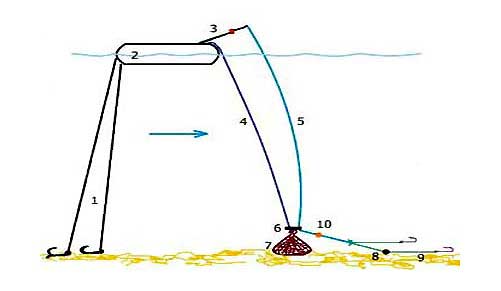
Let's look at the basic drawing of a ring configuration suitable for catching bream in the summer on any river, including weak currents, from a boat in more detail. Below will be a drawing of the ring itself and a method for making the gear will be proposed.
Under number 1 in the drawing, the guy lines and boat anchors are shown, and everything that is shown on the right belongs to the ring equipment for catching bream. My anchors are homemade, made with my own hands from round massive bronze blanks. The paired anchor arms are removable.
Here we can highlight the first difference between the ring and a regular side bottom fishing rod. On the ring, the feeder is lowered only from the side of the current coming from under the boat.
(Before starting the process of catching bream on a pair of ordinary donks, my feeder is lowered into the current from the side of the boat opposite from the gear. If you look at the drawing, it’s between the anchors. Therefore, large bream tangling the donkey rig with the feeder cord is very rare.)
He marked his rubber two-seater boat “Omega-1” with the number 2 in the drawing, and the number 3 was assigned to the onboard bottom tackle. The fishing rod and ring equipment for catching bream in a reeled form is shown in the photograph.
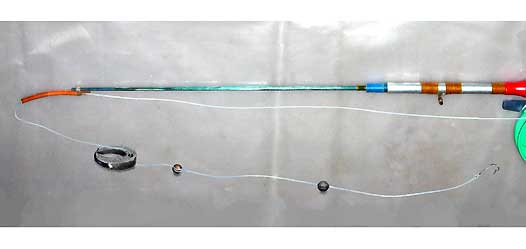
A thin nylon cord or thick fishing line, on which the ring feeder is lowered from the side of the boat, is indicated in the drawing by the number 4.
5. Line and its deflection when fishing for bream with a ring in a strong river current.
6. The hand-made gear ring, around which all the fuss is tied when catching bream and other fish with a ring in the current from a boat, is assigned the number 6 in the drawing. Below, according to the test, is a drawing of a ring for catching bream with a soldered pressure spring.
7. In this form, the drawing shows a feeder filled with food, located in the same stream with the nozzle on the hook of the ringing equipment.
8. Loading a long leash with a lead pellet, which is needed in order to press the nozzles on the hooks of the ring to the river ground if bream is caught from the bottom.
9. Leashes with hooks, which must be spaced apart when fishing for bream in the current with a feeder located under the boat.
10. The lower plastic limiter for the movement of the ring along the main line of the ring, which is shown larger in the following drawing.
Features of ring fishing from a boat
Catching carp with a ring from a boat differs significantly from catching bream and has the following features: 1. To prepare bait for catching carp, additional flavoring is used. For this purpose, both artificial substances and attractants of natural origin can be used.
Experienced fishermen use a short spinning rod for this fishing method; you can also use a simple flexible whip. It is important that the “nod” of the fishing rod shows the reaction to a bite well. Fish are caught using a reel or the fishing line is simply selected by hand.
How to catch more fish? I have been actively fishing for quite some time and have found many ways to improve the bite. And here are the most effective ones: Bite activator.
Attracts fish in cold and warm water with the help of pheromones included in the composition and stimulates its appetite. It’s a pity that Rosprirodnadzor wants to impose a ban on its sale.
More sensitive gear. Reviews and instructions for other types of gear can be found on the pages of my website.
Lures using pheromones. You can get the rest of the secrets of successful fishing for free by reading our other articles on the site.
The fishing line is chosen to be 0.2-0.25 mm, the length of the leashes should be 1.5 meters with a diameter of 0.15 mm, so that the current carries them away from the feeder. It is recommended to use 0.25 mm fluorocarbon line.
Hook sizes range from No. 6 to 8, and when catching larger fish, larger sizes are suitable.
